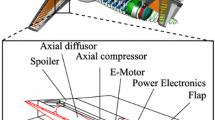Conclusion
-
1.
Employing graphical relationships between height of lift of the emulsion, depth of shaft, and specific air rate, it is possible to resolve the problem of optimum air-lift design, providing maximum efficiency of the rig with minimum construction costs.
-
2.
Analysis of the losses in lifting emulsion in the injection pipe and energy consumption for compressing air in the compressor has yielded a new design, providing higher-efficiency air lifts and a reduction in the depth of the shaft.
-
3.
By improving the energy characteristics of air lifts it is possible to use them in hydraulic engineering construction, reducing the construction and operating costs and improving the reliability of rigs for lowering water levels.
Similar content being viewed by others
Additional information
Translated from Gidrotekhnicheskoe Stroitel’stvo, No. 10, pp. 49–52, October, 1970.
Rights and permissions
About this article
Cite this article
Khlopenkov, P.R. Air-Lift design theory. Hydrotechnical Construction 4, 969–973 (1970). https://doi.org/10.1007/BF02435068
Issue Date:
DOI: https://doi.org/10.1007/BF02435068




